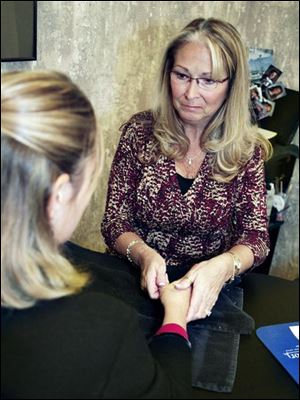
Arthritis targets all ages; chronic joint pain is becoming a workplace issue
11/16/2007
Lynda Babiak, a nail technician who suffers from osteoarthritis, recently finished a month-long series of twice-a-week sessions to deal with her illness. She learned to use an exercise ball and band for strengthening to help her cope with the condition. About a third of Americans say arthritis has limited their ability to work.
One morning 25 years ago, Lynda Babiak woke up and realized she suddenly had trouble bending her fingers, knees, and toes.
The mother of two small children was diagnosed with rheumatoid arthritis, most often diagnosed in women of child-bearing years. She was incredulous she had the chronic disease mainly characterized by inflamed joint linings.
"When I was 30, I had no idea what rheumatoid arthritis was," Mrs. Babiak of Sylvania recalled. "You think old people have arthritis."
Often thought of as a condition affecting grandparents and retirees with creaking joints, there are multiple kinds of arthritis, many of which - like rheumatoid - affect young people, said Mary Wright, occupational therapist at the Arthritis and Osteoporosis Center at Toledo Hospital.
About a third of Americans with arthritis say the condition has limited their ability to work, according to a Centers for Disease Control and Prevention report released last month.
And as the U.S. population ages and starts dealing with osteoarthritis, the most common form, the condition will become a bigger issue for both employers and employees, said Dr. Harvey Popovich, an occupational medicine physician with Mercy Health Partners.
"By the time you're in your 50s and 60s, it's pretty common," Dr. Popovich said of the kind of arthritis associated with aging often found in hands.
There are 21 million Americans with osteoarthritis and 2.1 million with rheumatoid arthritis, another common form, according to the Arthritis Foundation.
Still, there are ways to relieve arthritis pain and improve function. Dr. Popovich said those with common osteoarthritis should maintain an active lifestyle and use over-the-counter pain relievers, such as acetaminophen and naproxen.
Workers should be reassigned or retrained for other positions if they cannot continue their current jobs, he said.
With rheumatoid arthritis, a common form affecting 2.1 million Americans, getting the condition diagnosed early so it can be treated medically and therapeutically is key, Ms. Wright said.
Exercising to be strong and flexible; protecting joints to decrease strain, and conserving energy are ways to cope, she said.
At the Arthritis and Osteoporosis Center, patients get physical and occupational therapy to help them with everyday tasks.
Mrs. Babiak, who needs prescription medications and also has osteoarthritis, recently finished a month-long series of twice-a-week sessions at the center, where she learned to use an exercise ball and band for strengthening.
Figuring out ways to do her job as a nail technician at Creative Headlines in Sylvania Township without as much strain was part of the sessions, and she received ultrasound treatments for pain relief, she said.
Giving pedicures is the most painful part of her job, and her hips suffer from the way she has to sit and bend to give them, Ms. Babiak said.
But she enjoys being a nail technician and is able to work just 20 hours a week, which cuts down on strain, she said.
"I don't think I want to change," Mrs. Babiak said. "Then it would be putting my disease in control and not me, and I refuse to do that."
Contact Julie M. McKinnon at:
jmckinnon@theblade.com
or 419-724-6087.